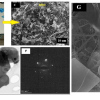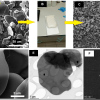Exfoliation method to produce 2D-layred materials (2DLMs)
Technology description
| The name of the technology: | Exfoliation method to produce 2D-layred materials (2DLMs) |
|---|---|
| Challenge: | Development teams worldwide have been intensifying efforts over the last decade to create industrially viable technology for producing two-dimensional layered materials (2DMLs) with high-volume production, scalability, and affordability. This drive is fueled by the expanding range of applications (transistors, semiconductors, sensors, batteries, solar cells, optics, hydrogen management, biomaterials, etc.) and the growing demand for various types of 2DMLs. Traditional production methods (mechanical, chemical) are limited by high energy consumption, toxic substances, and low production capacity. Our proposed, laboratory-validated process overcomes these challenges and offers a scalable, industrial solution. |
| Description: |
Ours invention proposes a highly versatile, low-cost, eco-friendly strategy for the high-yield exfoliation of 2DLMs (figure 1A) up to mono- or few-layers- nanosheets (figures 1C-E) using a highly viscous water-based semi-solid paste containing sodium silicate (waterglass) and cellulose fibres (figure 1B). Our exfoliating medium is universal, as it is suitable to produce various types of nanosheets, in particular: graphene (Gs), Boron hexagonal nitride nanolayers (h-BN - BNNSs), MXene nanolayers, aluminosilicate nanolayers, transition metal dichalcogenides (e.g. MoS₂), nanoclays, etc. The exfoliating medium can also be used for storage of 2DLMs, especially effective in preventing sedimentation of nanolayer particles. The high viscosity of our exfoliating medium also prevents restacking, as all the diffusive and Brownian motions occurring in low-viscosity fluids are here suppressed. Moreover, high viscosity allows the generation of high shear stresses at low deformation rates, implying lower energy consumptions and a higher control on the deformation mode, preventing collateral damage and defect formation in the material during exfoliation (see figures 1D, E). Another peculiarity of our invention consists of designing a new-generation nanocomposite based on unique blends of nanosheets and cellulose fibers (figure 1G), thus combining the properties of these nanomaterials for new intriguing applications. Main benefits: • Universal solution - exfoliation of both apolar (Gs, BNNSs) or polar (montmorillonites, cloisites, saponites etc.) precursors, owing to the amphiphilic character of cellulose fibres. • Cost-effective and eco-friendly – using an aqueous medium, inexpensive raw materials, non-toxic solvents. • Highly cost and energy efficient - exfoliation up to mono and few-layer nanosheets (NS) in minutes without utilization of expensive machineries. • Low shear-rate exfoliation method - ensures intact, unfolded, and defect-free NS with unprecedented aspect ratios. • Controlled slow deformation led to the formation of aligned cellulose fibres/2DLMs structure, with planar direction parallel to the shear directory, which could be used as template for nanocomposites fabrication. • The paste is fully recyclable, thus enormously limiting the raw material consumption. • The cellulose-waterglass mix prevents the sedimentation and restacking of the exfoliated NS, irrespective of the type of 2DLMs. |
| Commercial opportunity: |
• Application 1: Technology development into scalable industrial production of various 2DLMs materials (Gs, BNNSs, montmorillonites, cloisites, MXene nanolayers, aluminosilicate nanolayers, MoS₂). • Application 2: Technology development of specific industrial applications of the 2DLMs materials (Possible areas of application: Dielectric layers, Insulating layers; Thermally conductive materials + Electrical insulators; New composite materials; Anticorrosion protection; UV protection; Supercapacitors; Batteries; Optical protection, Biocompatible materials; Antibacterial layers; Transistors, Flexible and transparent displays, Photovoltaic cells, Various sensors including gas, bio, chemical sensors, Supercapacitors; Fuel cells, and so on). |
| IP protection status: | International patent application: PCT/SK2023/050004 - A liquid phase exfoliation method and an exfoliating medium. |
| Development status: |
Phase 2Corresponds with TRL 3 and TRL 4 Feasibility study. There is a realistic design of the technology and the initial tests in the laboratory are leading to the specification of the technology requirements and its capabilities.
|
| Partnering strategy: | Collaboration licensing |
| More information: |
Ing. Luca Bertolla, Ph.D., of IPM CAS, and Ing. Gianmarco Taveri, Ph.D., of CEMEA SAS, are collaborating on the advancement of this technology. Image description: A) Pristine h-BN powder, B) snapshot illustrating the exfoliating medium; C) BNNSs produced by the present method; D) SEM and E) TEM image showing the defectless morphology of the BNNSs; F) TEM diffraction pattern confirming the few-layer character of the produced BNNSs; G) SEM image of BNNS nanosheets covered by cellulose fibers. |
| Images: | |
| Categories: | Nanotechnology |
| Institution: | Institute of Physics of Materials CAS |
| Owner of a technology: | Ústav fyziky materiálů AV ČR, v. v. i.; Centrum pre využitie pokročilých materiálov SAV, v. v. i. (CEMEA) |

